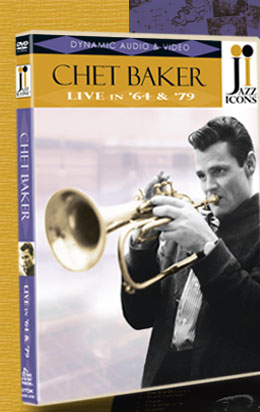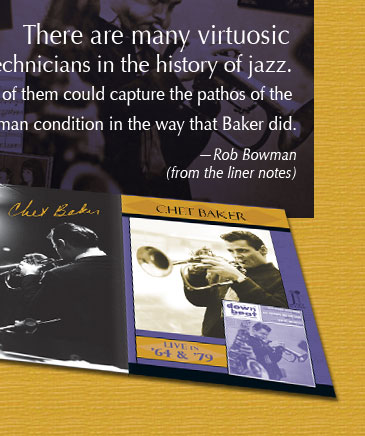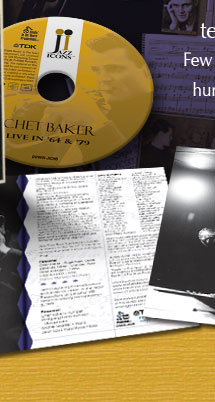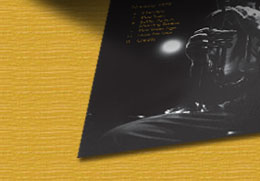




 |
 |
|
|||
|
|
|
||||
|
|
|
||||
|
|
|
||||
|
|
|
||||
 |
|
||||
 |
|
||||
 |
|
||||
|
|
|
|
|
|
|
 |
 |
 |
 |
Jazz Icons: Chet Baker features two concerts by the foremost interpreter of the West Coast school of cool jazz. Filmed in Europe 15 years apart, these two shows seen together provide an overview of Baker’s illustrious career. The first show is a haunting 1964 performance in a Belgian TV studio with a quartet including long-time sidemen saxophonist Jacques Pelzer and French pianist Rene Urtreger. Songs include the Miles Davis classic, “So What,” and the jazz standard “Time After Time” (a very rare rendition featuring Chet’s “Cool” vocal style.) The soulful1979 set from Norway, with a trio featuring vibraphonist Wolfgang Lackerschmid, highlights the growth and maturity of this troubled but inspiring artist. |
|
 |
|
|
Flugelhorn, Vocal: Chet Baker Alto Sax, Flute: Jacques Pelzer Piano: Rene Urtreger Bass: Luigi Trussardi Drums: Franco Manzecchi |
Bye Bye Blackbird Isn’t It Romantic Airegin Time After Time So What |
 |
|
|
Trumpet: Chet Baker Vibraphone: Wolfgang Lackerschmid Piano: Michel Graillie Bass: Jean Louis Rassinfoss |
Interview Blue Train Softly, As In A Morning Sunrise Five Years Ago Love For Sale |
16-page booklet Foreword by Chet's son Paul Baker Liner notes by Rob Bowman Cover photo by Chuck Stewart Booklet photos by Lee Tanner, Karlheinz Klüter, Carole Reiff Memorabilia collage Total time: 71 minutes |
|
|
Foreword: When I watch my father create music and I think about the life he had, the beauty of his artistic offerings always amazes me. Born in Oklahoma and enduring a major portion of the Depression as a child, there is always a poignant measure of melancholy in his voice reflective of the experience. But then comes the “West Coast Cool”— the rich, warm, inspired sound of his horn and it creates the whole spectrum of artistic expression that is the heart of the classic Chet Baker sound. I hope you enjoy this DVD. Paul Baker
Sample Liner Notes by Rob Bowman: Beauty comes in many forms. In music, it can be the result of a perfectly constructed melodic line, a harmonic voicing that sends shivers down your spine, a groove that somehow captures the joy of being alive, or a timbre so sensuously rich that it makes your body quiver from head to toe. In the case of Chet Baker, a jazzman capable of spinning out some of the most achingly beautiful music human beings have ever known, beauty was a result of finding the poignancy in sorrow, in deploying pitch inflection, melodic arc and a vibratoless timbre to conjure up something of rarefied value in a life of addiction and endless disappointment. There are many virtuosic technicians in the history of jazz. Few of them could capture the pathos of the human condition in the way that Baker did. Born just before Christmas 1929 to a cloying mother and a father whose own failed dreams of being a musician drove him to misery, Baker’s childhood knew few happy moments. While his father for a short period played banjo and guitar in country and western swing bands, his true love was jazz, his favorite player being trombonist Jack Teagarden. One day in 1943 on his way home from work he spotted a trombone in a pawnshop and, inspired by his own dreams, decided to buy it for his thirteen year old son. Unfortunately, Baker, short for his age, found the slide unmanageable and within a few days the trombone had been traded in for the much smaller trumpet. Shortly after acquiring the trumpet, Baker lost a tooth while playing on the street with some friends. While his mother procured for him a removable tooth, he seldom wore it and instead kept his mouth closed most of the time, developing a half smile that became a visual trademark for the rest of his life (on this DVD you can see the gap in his mouth where the tooth is missing when he sings Sammy Cahn’s and Jules Styne’s “Time After Time”). The missing tooth served to limit Baker’s range on the instrument. While he was criticized much of his life for his consequent inability to play flashy high register arabesques, as was the norm for many young testosterone-loaded trumpeters, Baker took this limitation and made it into an asset, developing a facility for melodic invention in the middle range perhaps only equaled by Miles Davis. ... In the summer of 1963, Baker pawned his trumpet for dope money. When a French musician came to his aid by loaning him a flugelhorn, Baker found himself enamored with the mellower sound of the slightly larger instrument and ended up playing it for years. It is the wider belled flugelhorn that Baker is playing in the thirty-plus-minute program from Belgian television included on this DVD. The quartet he chose to play with—Belgian alto saxophonist and flautist Jacques Pelzer, the French pianist Rene Urtreger and the Italian battery of Luigi Trussardi on bass and Franco Manzecchi on drums—was superb. Pelzer was a part-time musician and full-time drug store owner who became one of Baker’s closest friends, playing with him in countless shows as early as 1962 and continuing through at least the late 1970s. The classically trained Urtreger had toured with Miles Davis in 1956 and 1957 and played on Davis’ French recording Ascenceur pour L’Echafaud. He played with Baker as early as June 1963. Over the course of his career, Urtreger also accompanied such visiting jazz luminaries as Don Byas, Buck Clayton, Dizzy Gillespie, Stan Getz and Lee Konitz. Trussardi and Manzecchi were also first call accompanists for many visiting American musicians, collectively and singly gigging and/or recording with Eric Dolphy, Donald Byrd, Dexter Gordon, Hank Mobley, Teddy Wilson and France’s own Stéphane Grappelli. While the set is short, the five songs the Chet Baker Quintet performed that night in Brussels cover a lot of ground. On the opener, “Bye Bye Blackbird,” Baker’s tone is both strong and airy at the same time. Notice the way he draws emotion out of his mostly mid-register lines by inflecting pitches slightly flat. Also note the contrapuntal long notes played by Baker under Pelzer’s solo and the counterpoint woven by Pelzer at the end while Baker restates the head. ... The highlight of the set and perhaps of this whole DVD is the drummer-less quartet’s near-fifteen-minute version of Cole Porter’s “Love For Sale.” Baker had recorded the tune in 1977 in a funk version with Michael Brecker, John Scofield, and Tony Williams on the LP You Can’t Go Home Again. Here Baker unleashes all the stops, demonstrating a tremendous sense of time and mastery of breath while Rassinfosse plays a tension-inducing call and response bass ostinato. In many respects, this performance represents a rocking aesthetic that is diametrically opposed to Baker’s usual cool. It burns from beginning to end and like all great performances leaves you wanting more. Taken together, these two shows, filmed fifteen years apart present Baker playing in very different contexts. Given his loss of teeth following his 1966 beating and his crippling drug addiction that dominated the majority of his waking hours in that fifteen year interval, it is remarkable how consistent his overall aesthetic is. This is chamber jazz at its most delicate, relying on a refined sense of dynamics, melodic invention, counterpoint and, most importantly, emotional vulnerability. As a whole, it contains all the reasons why, despite his personal problems, Chet Baker remains one of the finest soloists and vocalists in the history of jazz. All words and artwork on this page ©Reelin' In The Years Productions. Unauthorized use is prohibited.
|
|
Site contents ©Copyright 2006 Reelin' In The Years Productions
Site designed by Tom Gulotta